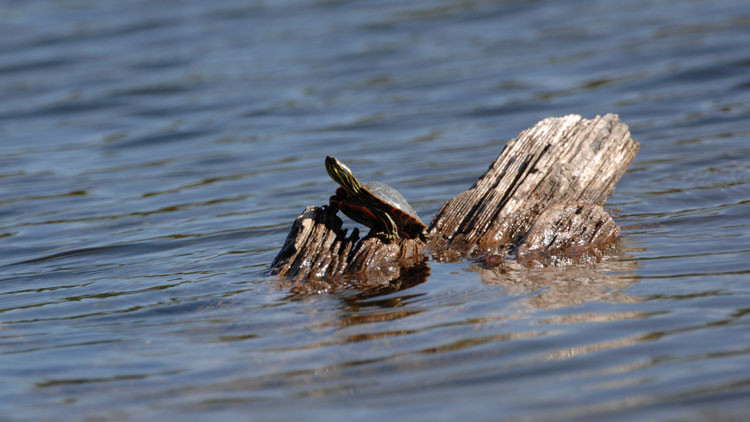Overview
Reptiles are cold-blooded vertebrates including lizards, snakes and turtles that are typically covered by scales or bony plates. Reptiles rely on the temperature of their environment to regulate their blood temperature and hibernate during winter.
Many of Alberta’s reptiles have limited, local distributions and may therefore be more vulnerable to site-specific habitat changes than other taxonomic groups.
Major threats to reptiles include habitat loss and fragmentation including the destruction of hibernacula (overwintering shelters), traffic mortality, predation, direct human persecution and invasive species.
Use keyboard or mouse to scroll through the gallery
General status
In 2020, 9 native reptile species were included in Alberta’s general status assessment, including 8 snakes and lizards and one turtle (Figures 1 and 2):
- Six reptiles (67%) were ranked sensitive:
- Bullsnake (Pituophis catenifer)
- Common Garter Snake (Thamnophis sirtalis)
- Plains Garter Snake (Thamnophis radix)
- Prairie Rattlesnake (Crotalis viridis)
- Terrestrial Garter Snake (Thamnophis elegans)
- Western Painted Turtle (Chrysemys picta)
- One reptile (11%) was ranked may be at risk: Western Hognose Snake (Heterodon nasicus)
- One reptile (11%) was ranked at risk: Greater Short-horned Lizard (Phrynosoma hernandesi)
- One reptile (11%) was ranked undetermined: Eastern Yellow-bellied Racer (Coluber constrictor)
Prairie Rattlesnake (Crotalis viridis) is the only reptile species with a change in status over the last 20 years. Its general status improved from ‘may be at risk’ to ‘sensitive’ in 2015.
One previously not assessed species, Eastern Yellow-bellied Racer (Coluber constrictor), was ranked in 2015, leaving no reptile species unassessed in 2020 (see Figures 1 and 2).
Among all vertebrates, reptiles have the second largest proportion of species ranked ‘at risk’ and ‘may be at risk’ (22%) with no reptile ranked secure in Alberta during the last 5 status evaluations from 2000 to 2020 (see Figure 1).
Detailed status
As of January 2024, 2 reptile species have detailed status designations including one listing under Alberta’s Wildlife Act:
- Greater Short-horned Lizard (Phrynosoma hernandesi) is listed as Endangered under the Wildlife Act.
- Prairie Rattlesnake (Crotalis viridis) has a detailed status of Special Concern.
Resources
- Reptile Identification (Alberta Conservation Association)
- Alberta Volunteer Amphibian Monitoring Program
Charts
Figure 1. Number of native reptile species and their respective general status ranks in Alberta between 2000 and 2020
Chart data table
| Year | Sensitive | May be at risk | At risk | Not assessed | Undetermined |
|---|---|---|---|---|---|
| 2000 | 5 | 2 | 1 | 1 | |
| 2005 | 5 | 2 | 1 | 1 | |
| 2010 | 5 | 2 | 1 | 1 | |
| 2015 | 6 | 1 | 1 | 1 | |
| 2020 | 6 | 1 | 1 | 1 |
Accessible chart description
Stacked bar graph showing the general status ranks of Alberta’s 9 native reptile species over time in 5-year intervals from 2000 until the latest assessment in 2020. In 2020, 6 reptiles (67%) were ranked sensitive, one reptile (11%) was ranked may be at risk, one reptile (11%) was ranked at risk, and one reptile (11%) was ranked undetermined. No reptile was ranked secure in Alberta during the last 5 status evaluations.
Figure 2. Proportion of general status ranks for Alberta’s native reptiles in 2020
Chart data table
| General status rank | Count of species |
|---|---|
| Sensitive 67% | 6 |
| May be at risk 11% | 1 |
| At risk 11% | 1 |
| Undetermined 11% | 1 |
Accessible chart description
Pie chart showing the proportion of general status ranks for Alberta’s 9 native reptile species in 2020. Total number of reptile species and the respective percentage are provided for each general status rank. In 2020, 6 reptiles (67%) were ranked sensitive, one reptile (11%) was ranked may be at risk, one reptile (11%) was ranked at risk, and one reptile (11%) was ranked undetermined.



